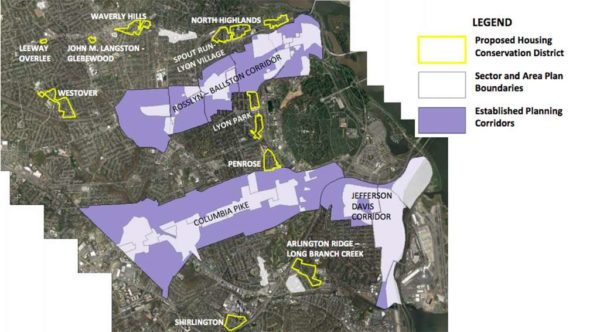 Peter’s Take is a weekly opinion column. The views and opinions expressed in this column are those of the author and do not necessarily reflect the views of ARLnow.com.
Peter’s Take is a weekly opinion column. The views and opinions expressed in this column are those of the author and do not necessarily reflect the views of ARLnow.com.
ARLnow.com reported last week that the County Board is planning to vote at a public hearing in December to allow the creation of “Housing Conservation Districts.”
The currently-proposed districts are bordered in yellow on this map accompanying that ARLnow story:
Discussion
The vote the Board should cast this month is to send the entire Housing Conservation District proposal back to the drawing board.
There are far too many serious:
- policy questions that require months’ more study, analysis, and civic engagement
- legal issues, including possible Fifth Amendment regulatory takings
Some of these concerns were highlighted by speakers at the recessed County Board meeting on November 27.
These concerns cannot be resolved appropriately this month.
It makes no sense to vote on the advertised Phase I without a full understanding of all the implications of Phase II (or any other subsequent phases).
Some of the things we don’t know about Phase II include:
- Property rights of existing owners: The owners’ value/rights might be enhanced by adding more development options, or might be diminished because the committed affordable (CAF) requirements and other things extracted in exchange for added density are too high to make it worth it. Favorable details would reduce law suit risks for the County (regulatory takings); unfavorable details would enhance such risks. Significantly, on November 27, major developer and ownership interests appeared, expressed willingness to work transparently on the details with the County and its residents, but strongly opposed a vote in December on the phased process envisioned in the advertisement.
- Effects on affordable housing: If the policy on net tilts towards allowing new building options, vs being focused on restricting redevelopment, this might prompt the addition of a lot more units. But, details are critical. How many market rate units would be added (helping put downward pressure on price in that segment) vs how many are CAFs, adding to supply in that segment? If the burdens placed/number of extractions demanded for this new development are too high, then we essentially rope off prime land.
- Budgetary implications: Who knows, and how can it be prudent to proceed without knowing? One staff slide had a line on it, “funding source needs to be identified.” Is this going to be a new public expenditure/a tax exemption? Is this going to be another transfer/extraction from developers, which could further push up market rate rents? What are the impacts on school funding, etc., etc.?
- Neighborhood interests: How much density will be added and where will it be added? Will the added options still have to conform to the current height and dwelling unit restrictions? Is it just about making infill easier within current limits, or is this about true up-zoning? For properties like these which are not in the Metro corridors, traffic and parking impacts do become great concerns, but since critical details are unknown, the neighbors, the public and the County Board are all left clueless.
Conclusion
Arlington’s Economic Development Commission has voted unanimously against this way of proceeding. The Arlington Chamber of Commerce, various other business groups, and the Lee Highway Alliance oppose the process and timeline envisioned by the advertisement.
What’s the rush?
Don’t vote on Phase I until the Arlington community fully understands all the implications of all the phases.


